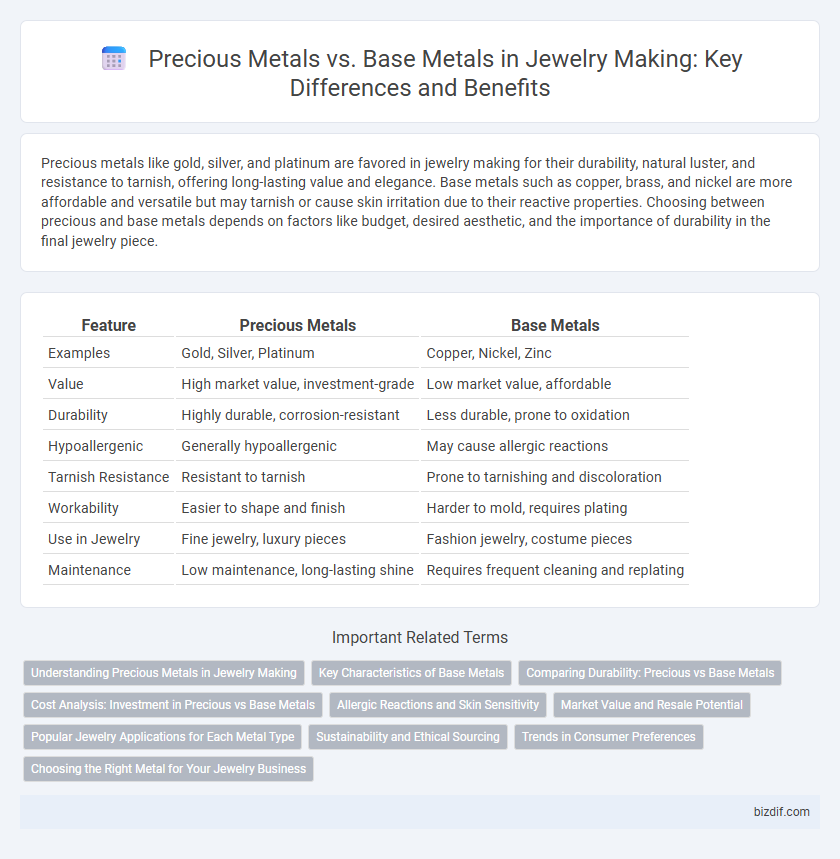Precious metals like gold, silver, and platinum are favored in jewelry making for their durability, natural luster, and resistance to tarnish, offering long-lasting value and elegance. Base metals such as copper, brass, and nickel are more affordable and versatile but may tarnish or cause skin irritation due to their reactive properties. Choosing between precious and base metals depends on factors like budget, desired aesthetic, and the importance of durability in the final jewelry piece.
Table of Comparison
| Feature | Precious Metals | Base Metals |
|---|---|---|
| Examples | Gold, Silver, Platinum | Copper, Nickel, Zinc |
| Value | High market value, investment-grade | Low market value, affordable |
| Durability | Highly durable, corrosion-resistant | Less durable, prone to oxidation |
| Hypoallergenic | Generally hypoallergenic | May cause allergic reactions |
| Tarnish Resistance | Resistant to tarnish | Prone to tarnishing and discoloration |
| Workability | Easier to shape and finish | Harder to mold, requires plating |
| Use in Jewelry | Fine jewelry, luxury pieces | Fashion jewelry, costume pieces |
| Maintenance | Low maintenance, long-lasting shine | Requires frequent cleaning and replating |
Understanding Precious Metals in Jewelry Making
Precious metals such as gold, silver, and platinum are prized in jewelry making for their rarity, durability, and resistance to tarnish, which enhances the longevity and value of the pieces. These metals offer superior malleability and hypoallergenic properties compared to base metals like copper or brass, making them ideal for intricate designs and sensitive skin. Understanding the intrinsic qualities and market value of precious metals is essential for crafting high-quality, timeless jewelry collections.
Key Characteristics of Base Metals
Base metals like copper, brass, and nickel are valued in jewelry making for their affordability, durability, and resistance to corrosion compared to precious metals such as gold and silver. These metals exhibit high tensile strength and excellent malleability, allowing intricate designs while maintaining structural integrity. Their naturally darker hues provide unique aesthetic options, often used as a contrast in mixed-metal jewelry pieces.
Comparing Durability: Precious vs Base Metals
Precious metals such as gold, platinum, and silver exhibit superior durability and resistance to tarnish compared to base metals like copper, zinc, and nickel, which tend to corrode and oxidize more rapidly. Gold's inherent malleability allows it to withstand daily wear without significant damage, while platinum offers exceptional hardness, making it ideal for long-lasting jewelry. Base metals, although more affordable, require frequent maintenance and are prone to scratches and discoloration over time, impacting the longevity of jewelry pieces.
Cost Analysis: Investment in Precious vs Base Metals
Precious metals such as gold, silver, and platinum involve higher initial investment costs due to their intrinsic value and market demand, significantly impacting jewelry pricing and resale value. Base metals like copper, brass, and nickel offer a budget-friendly alternative with lower material costs, enabling mass production but often sacrificing durability and market prestige. Investing in precious metals represents a long-term asset appreciation, while base metals prioritize affordability and volumetric output in jewelry design.
Allergic Reactions and Skin Sensitivity
Precious metals such as gold, platinum, and silver are less likely to cause allergic reactions or irritate sensitive skin due to their high purity and hypoallergenic properties. Base metals like nickel, copper, and brass often contain alloys that can trigger dermatitis and other allergic responses, making them less suitable for individuals with metal sensitivities. Choosing jewelry made from high-quality precious metals helps minimize the risk of skin irritation and ensures better comfort for those with allergies.
Market Value and Resale Potential
Precious metals like gold, silver, and platinum hold higher market value and strong resale potential due to their rarity and intrinsic worth. Base metals such as copper, brass, and nickel offer affordability but lack significant resale value and are more prone to corrosion. Investors and jewelers prioritize precious metals for long-term value retention and market demand.
Popular Jewelry Applications for Each Metal Type
Precious metals such as gold, silver, and platinum are favored in fine jewelry for their durability, hypoallergenic properties, and ability to retain value, making them ideal for engagement rings, wedding bands, and luxury watches. Base metals like copper, brass, and nickel are commonly used in fashion jewelry and costume pieces due to their affordability and ease of alloying, which allows for diverse designs and vibrant finishes. The choice between precious and base metals directly influences the jewelry's style, lifespan, and market appeal.
Sustainability and Ethical Sourcing
Precious metals such as gold, silver, and platinum are often sourced through mining practices that raise significant environmental and ethical concerns, including habitat destruction and exploitative labor conditions. Base metals like copper and brass generally have a lower environmental impact due to more accessible recycling processes and less intensive mining techniques, promoting greater sustainability. Ethical sourcing initiatives emphasize transparency and responsible mining certifications to ensure both precious and base metals meet stringent environmental and social standards in jewelry making.
Trends in Consumer Preferences
Consumer preferences in jewelry making have increasingly favored precious metals such as gold, platinum, and silver due to their durability, intrinsic value, and hypoallergenic properties. Base metals like brass and copper remain popular in fashion jewelry segments for affordability and versatility but face declining demand among luxury buyers. Market trends indicate a growing emphasis on ethical sourcing and sustainability, boosting the appeal of recycled precious metals in contemporary designs.
Choosing the Right Metal for Your Jewelry Business
Selecting the right metal for your jewelry business depends on factors like durability, cost, and target market preferences. Precious metals such as gold, silver, and platinum offer timeless value and high resale potential, while base metals like copper, brass, and stainless steel provide affordability and versatility for fashion-forward designs. Understanding the balance between market demand and production cost ensures optimal material choice for a competitive edge in the jewelry industry.
Precious metals vs Base metals Infographic

 bizdif.com
bizdif.com